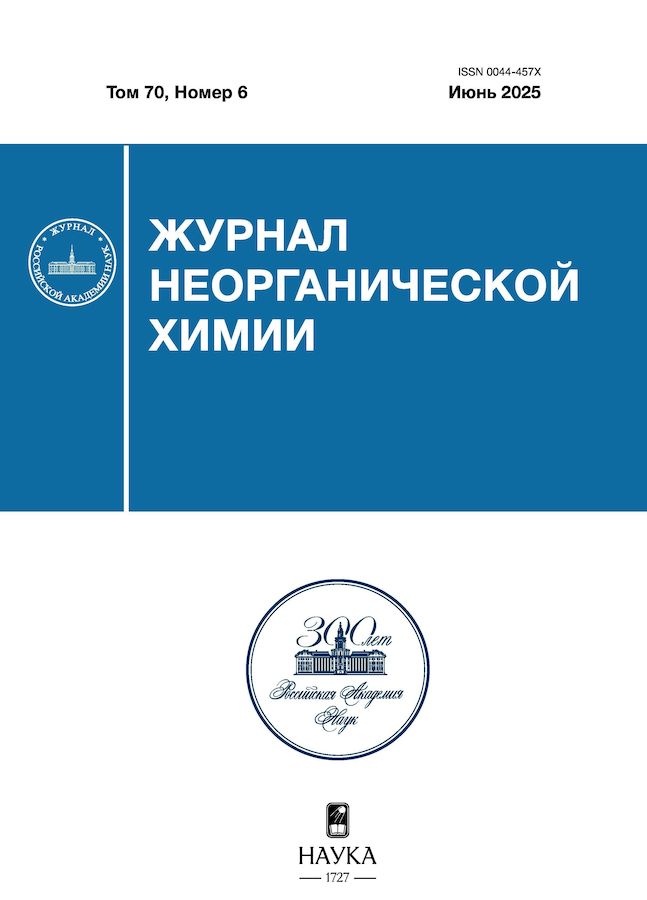Synthesis and Physicochemical Properties of Magnetic Fе3O4 Particles Doped with Gd(III)
- Авторлар: Mitskevich E.D.1, Degtyarik M.M.2, Kharchеnkо A.A.3, Bushinsky М.V.4, Fedotova J.A.3
-
Мекемелер:
- Belarusian State University
- Research Institute for Physical Chemical Problems of the Belarusian State University
- Research Institute of Nuclear Problems of the Belarusian State University
- Practical Center of the National Academy of Sciences of Belarus for Materials Science
- Шығарылым: Том 70, № 6 (2025)
- Беттер: 729-739
- Бөлім: СИНТЕЗ И СВОЙСТВА НЕОРГАНИЧЕСКИХ СОЕДИНЕНИЙ
- URL: https://clinpractice.ru/0044-457X/article/view/686347
- DOI: https://doi.org/10.31857/S0044457X25060018
- EDN: https://elibrary.ru/IBBNZF
- ID: 686347
Дәйексөз келтіру
Аннотация
Magnetic Fe3O4 nanoparticles were synthesized by alkaline precipitation of aqueous solutions of divalent and trivalent iron salts. Synthesis of Fe3−xGdxO4 nanoparticles (x = 0.05; 0.1) was performed by adding a calculated amount of Gd(NO3)3 6H2O to the initial solution of iron salt mixture. The phase composition and magnetic properties of the synthesized powders were investigated by X-ray phase analysis, Mössbauer spectroscopy on 57Fe isotope and magnetometry at temperatures T = 7, 20 and 300 K. The investigations confirmed the formation of nanoparticles of non-stehiometric Fe3−δO4 magnetite, as well as magnetite doped with Gd3+ ions. The correlation between the average diameter of nanoparticles of the initial Fe3−δO4 powder and doped Fe3−xGdxO4 powder and the salt used in the synthesis, as well as the concentration of Gd (x), respectively, was revealed.
Негізгі сөздер
Толық мәтін
Авторлар туралы
E. Mitskevich
Belarusian State University
Хат алмасуға жауапты Автор.
Email: fcfvvv12@gmail.com
Белоруссия, 4, Nezavisimost Ave., Minsk, 220030
M. Degtyarik
Research Institute for Physical Chemical Problems of the Belarusian State University
Email: fcfvvv12@gmail.com
Белоруссия, 14, Leningradskaya St., Minsk, 220030
A. Kharchеnkо
Research Institute of Nuclear Problems of the Belarusian State University
Email: fcfvvv12@gmail.com
Белоруссия, 11, Bobruyskaya St., Minsk, 220030
М. Bushinsky
Practical Center of the National Academy of Sciences of Belarus for Materials Science
Email: fcfvvv12@gmail.com
Белоруссия, 19, P. Brovka St., Minsk, 220072
J. Fedotova
Research Institute of Nuclear Problems of the Belarusian State University
Email: fcfvvv12@gmail.com
Белоруссия, 11, Bobruyskaya St., Minsk, 220030
Әдебиет тізімі
- Yasemian A.R., Almasi Kashi M., Ramazani A. // Mater. Chem. Phys. 2019. V. 230. P. 9. https://doi.org/10.1016/j.matchemphys.2019.03.032
- Koli R.R., Phadatare M.R., Sinha B.B. et al. // J. Taiwan Inst. Chem. Eng. 2019. V. 95. P. 357. https://doi.org/10.1016/j.jtice.2018.07.039
- Sharma K.S., Ningthoujam R.S., Dubey A.K. et al. // Sci. Rep. 2018. V. 8. № 1. P. 14766. https://doi.org/10.1038/s41598-018-32934-w
- Budnyk A.P., Lastovina T.A., Bugaev A.L. et al. // J. Spectr. 2018. P. 1412563. https://doi.org/10.1155/2018/1412563
- Araújo R., Castro A.C.M., Fiúza A. // Mater. Today Proc. 2015. V. 2. P. 315. https://doi.org/10.1016/j.matpr.2015.04.055
- Jiang B., Lian L., Xing Y. et al. // Environ. Sci. Pollut. Res. 2018. V. 25. P. 30863. https://doi.org/10.1007/s11356-018-3095-7
- Bagbi Y., Sarswat A., Mohan D. et al. // Sci. Rep. 2017. V. 7. №1. P. 7672. https://doi.org/10.1038/s41598-017-03380-x
- Li H.Q., Liu F., Zhang B.J. et al. // Russ. J. Inorg. Chem. 2023. V. 68. № 11. P. 1681. https://doi.org/10.1134/S0036023623601216
- Mojtahedi M.M., Abaee M.S., Rajabi A. et al. // J. Mol. Catal. Chem. 2012. V. 361. P. 68. https://doi.org/10.1016/j.molcata.2012.05.004
- Zhang H., Malik V., Mallapragada S. et al. // J. Magn. Magn. Mater. 2017. V. 423. P. 386. https://doi.org/10.1016/j.jmmm.2016.10.005
- Jesus A.C.B., Silva T.R., Almeida R.V. et al. // Ceram. Int. 2020. V. 46. № 8. P. 11149. https://doi.org/10.1016/j.ceramint.2020.01.135
- Xu R., Zhang J., Liu Y. et al. // ACS Appl. Mater. Interfaces. 2020. V. 12. № 33. P. 36917. https://pubs.acs.org/doi/10.1021/acsami.0c09952
- Zhang G., Zhang L., Si Y. et al. // Chem. Eng. J. 2020. V. 388. P. 124269. https://doi.org/10.1016/j.cej.2020.124269
- Li J., Li X., Gong S. et al. // Nano Lett. 2020. V. 20. № 7. P. 4842. https://doi.org/10.1021/acs.nanolett.0c00817
- Peng H., Cui B., Wang Y. // Mater. Res. Bull. 2013. V. 48. № 5. P. 1767. https://doi.org/10.1016/j.materresbull.2013.01.001
- Kahil H., Faramawy A., El-Sayed H. et al. // Crystals. 2021. V. 11. № 10. P. 1153. https://doi.org/10.3390/cryst11101153
- Palihawadana-Arachchige M., Naik V.M., Vaishnava P.P. et al. / Nanostructured Materials – Fabrication to Applications. BoD: Books on Demand (2017). https://doi.org/10.5772/intechopen.68219
- Jain R., Luthra V., Arora M. et al. // Adv. Sci. Eng. Med. 2019. V. 11. № 1–2. P. 88. https://doi.org/10.1166/asem.2019.2313
- Dhillon G., Kumar P., Sharma R. et al. // J. Mater. Sci. Mater. Electron. 2021. V. 32. № 17. P. 22387. https://doi.org/10.1007/s10854-021-06725-5
- Janani V., Induja S., Jaison D. et al. // Ceram. Int. 2021. V. 47. № 22. P. 31399. https://doi.org/10.1016/j.ceramint.2021.08.015
- Massart R. // IEEE Trans. Magn. 1981. V. 17. № 2. P. 1247. https://doi.org/10.1109/TMAG.1981.1061188
- Zhu N., Ji H., Yu P. et al. // Nanomaterials. 2018. V. 8. № 10. P. 810. https://doi.org/10.3390/nano8100810
- Lagarec K., Rancourt D.G. // Recoil-Mössbauer spectral analysis software for Windows. University of Ottawa, Ottawa, ON 43 (1998).
- Rancourt D.G., Ping J.Y. // Nucl. Instrum. Methods Phys. Res., Sect. B. 1991. V. 58. № 1. P. 85. https://doi.org/10.1016/0168-583X(91)95681-3
- Powder Diffraction File (PDF). The International Centre for Diffraction Data.
- Williamson G.K., Hall W.H. // Acta Metall. 1953. V. 1. № 1. P. 22. https://doi.org/10.1016/0001-6160(53)90006-6
- Johnson C.E., Johnson J.A., Hah H.Y. et al. // Hyperfine Interact. 2016. V. 237. P. 1. https://doi.org/10.1007/s10751-016-1277-6
- Kuchma E., Kubrin S., Soldatov A. // Biomedicines. 2018. V. 6. № 3. P. 78. https://doi.org/10.3390/biomedicines6030078
- Winsett J., Moilanen A., Paudel K. et al. // SN Appl. Sci. 2019. V. 1. Р. 1. https://doi.org/10.1007/s42452-019-1699-2
- Панкратов Д.А., Анучина М.М., Спиридонов Ф.М. и др. // Кристаллография. 2020. Т. 65. № 3. С. 393. https://doi.org/10.31857/S0023476120030248. Pankratov D.A., Anuchina M.M., Spiridonov F.M. et al. // Crystallogr. Rep. 2020. V. 65. № 3. P. 393. https://doi.org/10.1134/s1063774520030244
- Martinez-Boubeta C., Simeonidis K., Makridis A. et al. // Sci. Rep. 2013. V. 3. Р. 1652. https://doi.org/10.1038/srep01652
- Zhu W., Winterstein J., Maimon I. et al. // J. Phys. Chem. C. 2016. V. 120. № 27. P. 14854. https://doi.org/10.1021/acs.jpcc.6b02033
- Persson K. // Materials data on fe3o4 (sg: 227) by materials project. United States (2015). https://doi.org/10.17188/1194194
Қосымша файлдар















